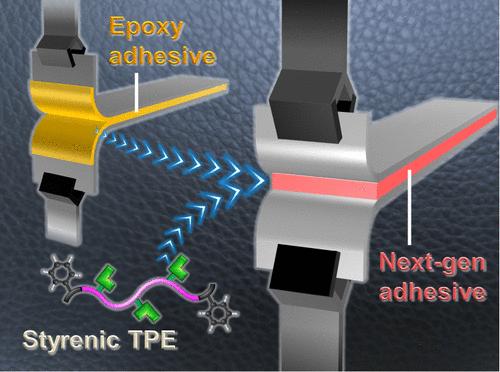由环氧树脂和氢键苯乙烯嵌段聚合物基热塑性弹性体组成的新一代结构粘合剂
IF 8.3
2区 材料科学
Q1 MATERIALS SCIENCE, MULTIDISCIPLINARY
引用次数: 0
摘要
结构粘合剂目前应用于汽车、飞机和建筑物的组装。其中,环氧树脂粘合剂因其出色的机械强度和耐用性而被广泛使用。然而,固化环氧树脂通常是刚性的,缺乏柔韧性,因此剥离强度和冲击强度较低。在本研究中,通过混合液态环氧预聚物(EP)和聚苯乙烯-b-聚异戊二烯-b-聚苯乙烯(SIS),开发出了韧性固化环氧粘合剂。SIS 是一种嵌段聚合物基热塑性弹性体(TPE),由可溶于液态 EP 的聚苯乙烯(S)和不溶于液态 EP 的聚异戊二烯(I)组成,其中 S 和 I 的玻璃化转变温度分别高于和低于室温。此外,通过混合液态 EP 和在 I 嵌段中含有氢键基团的 SIS(h-SIS),制备出比含有 SIS 的固化粘合剂更坚韧的固化粘合剂。透射电子显微镜(TEM)观察发现,S/固化 EP 混合畴(d 间距为几十纳米)和固化 EP 畴(直径为一百到几百纳米)宏观上分散在含有 SIS 或 h-SIS 的固化粘合剂的 I 或氢键 I 基质中。固化后的纯 EP(EP*)的搭接剪切强度、剥离强度和冲击强度分别为 23 MPa、45 N/25 mm 和 0.62 kN/m。同时,与固化 EP* 相比,含有 16.5 wt % SIS 的固化粘合剂的搭接剪切强度略低,为 17 MPa,而含有 SIS 的固化粘合剂的剥离强度和冲击强度分别为 61 N/25 mm 和 7.1 kN/m,均高于 EP*。此外,含有 15.5 wt % h-SIS 的固化粘合剂的搭接剪切强度为 21 兆帕,与固化 EP* 相似。含有 h-SIS 的固化粘合剂还具有出色的剥离强度(97 N/25 mm)和冲击强度(14 kN/m),是固化 EP* 的 22 倍。因此,与由纯 EP 组成的固化环氧胶粘剂相比,混合液体 EP 和 SIS 提高了固化环氧胶粘剂的固化胶粘剂性能和柔韧性,通过混合液体 EP 和带有氢键基团的 h-SIS 而不是混合 SIS,可进一步提高胶粘剂性能。本文章由计算机程序翻译,如有差异,请以英文原文为准。

Next-Generation Structural Adhesives Composed of Epoxy Resins and Hydrogen-Bonded Styrenic Block Polymer-Based Thermoplastic Elastomers
Structural adhesives are currently applied in the assembly of automobiles, aircraft, and buildings. In particular, epoxy adhesives are widely used due to their excellent mechanical strength and durability. However, cured epoxy resins are typically rigid and inflexible; thus, they have low peel and impact strength. In this study, tough cured epoxy adhesives were developed by mixing a liquid epoxy prepolymer (EP) and polystyrene-b-polyisoprene-b-polystyrene (SIS). SIS is a block polymer-based thermoplastic elastomer (TPE) composed of polystyrene (S) soluble in liquid EP and polyisoprene (I) insoluble in liquid EP, where S and I have a glass transition temperature that is higher and lower than room temperature, respectively. In addition, cured adhesives tougher than the cured adhesives containing SIS were prepared by mixing liquid EP and SIS with hydrogen-bonding groups in the I block (h-SIS). Transmission electron microscopy (TEM) observations revealed mixed S/cured EP domains, with a d-spacing of several tens of nanometers, and cured EP domains, with diameters of one hundred to several hundred nanometers, that were macroscopically dispersed in the I or hydrogen-bonded I matrix of the cured adhesive containing SIS or h-SIS. The lap shear, peel, and impact strength of cured neat EP (EP*) were 23 MPa, 45 N/25 mm, and 0.62 kN/m, respectively. Meanwhile, the cured adhesive containing 16.5 wt % SIS exhibited the slightly lower lap shear strength of 17 MPa compared to that of cured EP*, whereas the peel and impact strength of the cured adhesive with SIS were 61 N/25 mm and 7.1 kN/m, respectively, both higher than those of EP*. Furthermore, the lap shear strength of the cured adhesive containing 15.5 wt % h-SIS was 21 MPa, which was similar to that of cured EP*. The cured adhesive with h-SIS also exhibited an excellent peel strength of 97 N/25 mm and an impact strength of 14 kN/m which was 22 times higher than that of cured EP*. Therefore, mixing liquid EP and SIS improved the cured adhesive properties and flexibility of the cured epoxy adhesives compared to the cured adhesive composed of neat EP, and further enhancement of the adhesive properties was achieved by mixing liquid EP and h-SIS with hydrogen-bonding groups instead of mixing with SIS.
求助全文
通过发布文献求助,成功后即可免费获取论文全文。
去求助
来源期刊

ACS Applied Materials & Interfaces
工程技术-材料科学:综合
CiteScore
16.00
自引率
6.30%
发文量
4978
审稿时长
1.8 months
期刊介绍:
ACS Applied Materials & Interfaces is a leading interdisciplinary journal that brings together chemists, engineers, physicists, and biologists to explore the development and utilization of newly-discovered materials and interfacial processes for specific applications. Our journal has experienced remarkable growth since its establishment in 2009, both in terms of the number of articles published and the impact of the research showcased. We are proud to foster a truly global community, with the majority of published articles originating from outside the United States, reflecting the rapid growth of applied research worldwide.
 求助内容:
求助内容: 应助结果提醒方式:
应助结果提醒方式:


